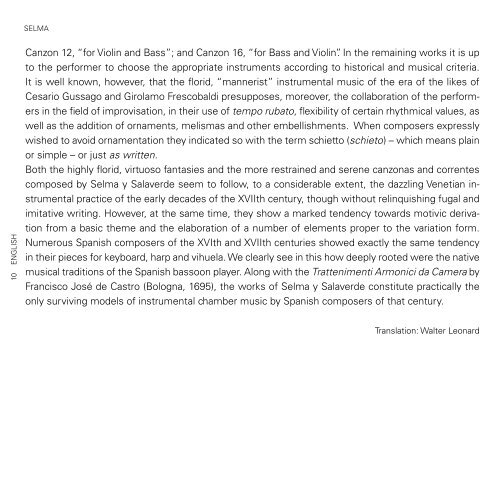Untitled - Enchiriadis
Untitled - Enchiriadis
Untitled - Enchiriadis
You also want an ePaper? Increase the reach of your titles
YUMPU automatically turns print PDFs into web optimized ePapers that Google loves.
10 ENGLISH<br />
SELMA<br />
Canzon 12, “for Violin and Bass”; and Canzon 16, “for Bass and Violin”. In the remaining works it is up<br />
to the performer to choose the appropriate instruments according to historical and musical criteria.<br />
It is well known, however, that the florid, “mannerist” instrumental music of the era of the likes of<br />
Cesario Gussago and Girolamo Frescobaldi presupposes, moreover, the collaboration of the performers<br />
in the field of improvisation, in their use of tempo rubato, flexibility of certain rhythmical values, as<br />
well as the addition of ornaments, melismas and other embellishments. When composers expressly<br />
wished to avoid ornamentation they indicated so with the term schietto (schieto) – which means plain<br />
or simple – or just as written.<br />
Both the highly florid, virtuoso fantasies and the more restrained and serene canzonas and correntes<br />
composed by Selma y Salaverde seem to follow, to a considerable extent, the dazzling Venetian instrumental<br />
practice of the early decades of the XVIIth century, though without relinquishing fugal and<br />
imitative writing. However, at the same time, they show a marked tendency towards motivic derivation<br />
from a basic theme and the elaboration of a number of elements proper to the variation form.<br />
Numerous Spanish composers of the XVIth and XVIIth centuries showed exactly the same tendency<br />
in their pieces for keyboard, harp and vihuela. We clearly see in this how deeply rooted were the native<br />
musical traditions of the Spanish bassoon player. Along with the Trattenimenti Armonici da Camera by<br />
Francisco José de Castro (Bologna, 1695), the works of Selma y Salaverde constitute practically the<br />
only surviving models of instrumental chamber music by Spanish composers of that century.<br />
Translation: Walter Leonard




